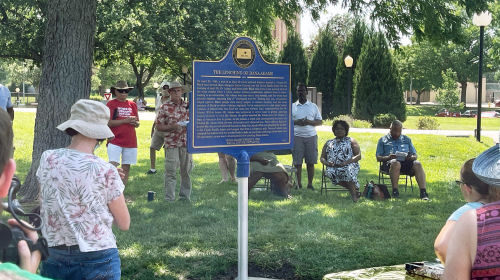Time doesn’t heal all wounds.
Some wounds fester and spread, inflaming and weakening surrounding tissues. Over time, some of these wounds prove fatal.
On Saturday afternoon in Salina, under a sweltering sun, more than 100 community members gathered to bind and disinfect a very old wound. On April 20, 1893, a Black man named Dana Adams was lynched there, one of at least 23 Black Kansans lynched between 1865 and 1950. His father later sued the city and received two dollars. A plaque detailing the lynching was being unveiled to remember him, to remind Salina of a past that all must understand to overcome.
“We all need to be part of this healing process. We don’t have one soul to spare, not one,” said Sandy Beverly, one of the three women whose vision and dedication made the marker — located in Robert Caldwell Plaza, between the public library and city-county building — a reality.
Or as Salina Mayor Trent Davis put it during his welcome to the crowd: “This marker commemorates a very sad, horrendous event. It is a reminder of the biblical sinking sand foundation of slavery and resentment upon which this country was built. As a historical marker, it should be an uncomfortable place to stand and ponder. … Yet as a historical marker, it can serve as the second cornerstone as this little piece of America seeks to rebuild its foundation.”
Folks gathered in the late June heat listened quietly. They had just enjoyed a barbecue lunch from North Salina Community Development, and the most powerful words of the afternoon were still to come.
I drove to Salina on Saturday to follow up on my column from October (my predecessor, C.J. Janovy, had written our first piece on the subject back in 2020).
The soil collection ceremony held then by The Dana Adams Project 1893 and the Equal Justice Initiative was an example, I wrote, of how a small city in the center of Kansas could grapple honestly with its history – as the rest of the nation tore itself apart.
This marker dedication was no less an example, but as the speeches proceeded, it also challenged the audience. In a passionate and exceptional central speech by Sheryl Wilson, director of the Newton-based Kansas Institute For Peace and Conflict Resolution. She talked about how trauma can be handed down through generations, how the death of one man in Salina scarred his family and wove tendrils of fear and sadness throughout the community.
“The trauma affiliated with how we transcend beyond what some other group of people might think we’re worth is something that we constantly have had to negotiate or renegotiate throughout the generations,” she said. “The trauma people deal with today is rooted in the knowledge of their perceived worth. That, on some scale, still is, as I said, something we’re having to deal with today.”
Yes, the marker shows a community coming to grips with its past. But the person-to-person work of rooting out entrenched bias and atoning for past wrongs remains. Columnist Mark McCormick wrote Sunday in Kansas Reflector about the economic damage done to Black communities by discrimination.
The emotional damage has been no less extreme.
“People want to know that they’re treated fairly and equitably in their communities,” Wilson said. “And so when we think about how that at that time, justice was absent, terror rained. And it’s exactly what Black people experienced in this community — a reign of terror. The assets of justice meant that anxiety is the norm for people who don’t have that luxury of feeling safe, and even expressing the norm of calm.”
I spoke with Wilson after the unveiling and asked what it meant to her to be invited to speak.
“It meant everything,” she said, connecting the story of Adams to critical work in restorative justice.
She had explained the concept earlier to the crowd.
“What restorative justice teaches us in this instance, is to look at the ways we can seek to repair the historical harm that has happened here, thinking about how we can reveal a story that was suppressed,” Wilson said. Ultimately, Saturday was a way “that we would work toward healing a community of people who have suffered generationally. That we would offer to give space to people to have meaningful, productive dialogue on how the community can come together, looking at ways to make all boats rise.”
_ _ _
Story and Photo by Clay Wirestone / Kansas Reflector



